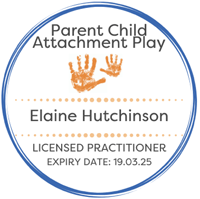As you might know, I often work with a ‘furry-side kick’ in my playroom. Orca, the therapy dog, is a collie poodle cross who adores sharing time with my clients. She’s only there if she’s wanted by the child or young person I am working with and we go through an introduction session first.
They can ask for her not to be there at any time and we cover a lot of ‘what ifs’ in our introductory meeting. Orca trained at Little Orchard Dog Training Academy, is regularly loved by Jo and Dave at Axe Valley Vets and is fully insured as a therapy dog.
A bit of background
Animals supporting us with our mental well-being is not new, and anyone who has owned and loved a pet will probably have many stories of how they have been supported and cared for in some way by their animal.
Animal assisted therapy (AAT) can trace its origins back to English Quakers, who first used animals as part of their mental health treatment of patients in 1792. In 1867 animals were used to help treat epileptic patients in Germany. Florence Nightingale recommended that animals were used alongside nursing care and animal therapy was also used at Bethlehem Hospital (the original and notorious ‘Bedlam’) and dog companions helped WW2 soldiers with their recovery from 1942.
Boris Levinson first used animal therapy to support children in 1953 and AAT has now become a mainstream therapy, with schools often having a ‘school dog’ or a visiting therapy dog.
The research behind the benefits of a therapy dog
There has been lots of research supporting how a dog can support a child or young person in therapy but what is most interesting is that the dog doesn’t have to do anything special to beneficial. Even a dog sleeping in the corner of a therapy room has been shown to be helpful. (This is of course assuming that everyone is happy for the dog to be there. It wouldn’t be quite so beneficial if the client didn’t like dogs!)

Research shows a child or young person is more likely to open up to a therapist when a dog is present and that sharing their troubles (including making disclosures) is easier for them when a dog is present as they could ‘tell’ the dog both through play and through physical interaction, which was easier for them than sharing directly with an adult. This research also showed that children and young people found it easier to talk about things that made them feel guilty or shameful if a dog was in the room, especially if a disclosure about sexual abuse was being shared.
Many animals are used to varying levels of success as therapy animals, but dogs are generally the best suited to working with us. There are many reasons why but some of them are listed here:
- dogs are essentially playful throughout their lives
- dogs are orientated to the present, they are in the moment and don’t appear to worry about the past or the future
- dogs seem accepting and non-judgemental in human-canine relationships and are attachment focused, apparently enjoying the connection with people they meet
- dogs appear to show empathy and they enjoy physical contact
Perhaps the most essential reason is that dogs can exhibit some of the behavioural and social problems that bring clients to the playroom, such as anxiety and trauma, and this shared history often facilitates connection
How Orca can help your child
In my playroom, children and young people who are struggling with friendships often connect to Orca, my therapy dog, because they know from the initial meeting that she was the last of her litter and no-one wanted her before she came to join my family. They identify with her perceived ‘unwantedness’ and feel a little less alone because they believe she shares their experiences. Her collie traits of trying to chase balls in the playground and getting task focussed to the point of ignoring children’s ‘sit’ commands when she is dancing on the end of her lead, also helps my hyperactive clients connect to her as they see her as being ‘a little bit naughty’ and needing to work on her behaviour management skills just like them.
The main benefits of having Orca in the playroom for a child or young person include:
- Increased relaxation
- Increased comfort level (and for anxious family members who come to meetings)
- Increased trust both of the therapist and the dog
- Increased rapport and communication
- Learning new skills such as responsibility, patience and communication
- Reduced anxiety and hyperactivity
- Making the therapy room feel more like ‘home’ if they are used to having pets
- Reduced stress and other body changes, including lowering blood pressure
- Increased motivation
(Orca would say the main benefits to her are love, fuss and treats!)
As you can see, there are far more benefits to your child or young person spending time with Orca in my room (assuming they want her to be there…) than you might think of, and it isn’t just me ‘bringing my dog to work’.
Orca and I look forward to meeting you and answering any questions you might have. (I’m good with the really easy questions, but Orca likes tricky conundrums!)






